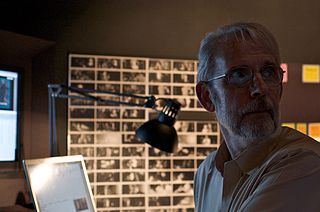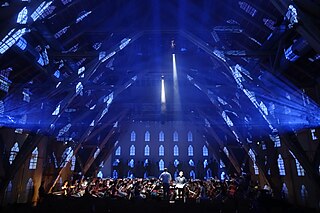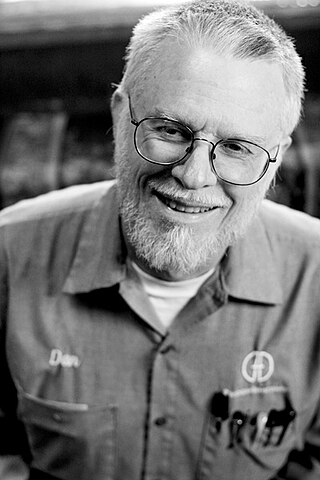A film crew is a group of people, hired by a production company, for the purpose of producing a film or motion picture. The crew is distinguished from the cast, as the cast are understood to be the actors who appear in front of the camera or provide voices for characters in the film. The crew is also separate from the producers, as the producers are the ones who own a portion of either the film studio or the film's intellectual property rights. A film crew is divided into different departments, each of which specializes in a specific aspect of the production. Film crew positions have evolved over the years, spurred by technological change, but many traditional jobs date from the early 20th century and are common across jurisdictions and filmmaking cultures.

A sound effect is an artificially created or enhanced sound, or sound process used to emphasize artistic or other content of films, television shows, live performance, animation, video games, music, or other media.

Post-production is part of the process of filmmaking, video production, audio production, and photography. Post-production includes all stages of production occurring after principal photography or recording individual program segments.

Surround sound is a technique for enriching the fidelity and depth of sound reproduction by using multiple audio channels from speakers that surround the listener. Its first application was in movie theaters. Prior to surround sound, theater sound systems commonly had three screen channels of sound that played from three loudspeakers located in front of the audience. Surround sound adds one or more channels from loudspeakers to the side or behind the listener that are able to create the sensation of sound coming from any horizontal direction around the listener.
A sound editor is a creative professional responsible for selecting and assembling sound recordings in preparation for the final sound mixing or mastering of a television program, motion picture, video game, or any production involving recorded or synthetic sound. The sound editor works with the supervising sound editor. The supervising sound editor often assigns scenes and reels the sound editor based on the editor's strengths and area of expertise. Sound editing developed out of the need to fix the incomplete, undramatic, or technically inferior sound recordings of early talkies, and over the decades has become a respected filmmaking craft, with sound editors implementing the aesthetic goals of motion picture sound design.

A digital audio workstation is an electronic device or application software used for recording, editing and producing audio files. DAWs come in a wide variety of configurations from a single software program on a laptop, to an integrated stand-alone unit, all the way to a highly complex configuration of numerous components controlled by a central computer. Regardless of configuration, modern DAWs have a central interface that allows the user to alter and mix multiple recordings and tracks into a final produced piece.

Walter Scott Murch is an American film editor, director, writer and sound designer. His work includes THX 1138, Apocalypse Now, The Godfather I, II, and III, American Graffiti, The Conversation, Ghost and The English Patient, with three Academy Award wins.

A sound reinforcement system is the combination of microphones, signal processors, amplifiers, and loudspeakers in enclosures all controlled by a mixing console that makes live or pre-recorded sounds louder and may also distribute those sounds to a larger or more distant audience. In many situations, a sound reinforcement system is also used to enhance or alter the sound of the sources on the stage, typically by using electronic effects, such as reverb, as opposed to simply amplifying the sources unaltered.
3D audio effects are a group of sound effects that manipulate the sound produced by stereo speakers, surround-sound speakers, speaker-arrays, or headphones. This frequently involves the virtual placement of sound sources anywhere in three-dimensional space, including behind, above or below the listener.
Filmmaking or film production is the process by which a motion picture is produced. Filmmaking involves a number of complex and discrete stages, beginning with an initial story, idea, or commission. Production then continues through screenwriting, casting, pre-production, shooting, sound recording, post-production, and screening the finished product before an audience, which may result in a film release and exhibition. The process is nonlinear, as the director typically shoots the script out of sequence, repeats shots as needed, and puts them together through editing later. Filmmaking occurs in a variety of economic, social, and political contexts around the world, and uses a variety of technologies and cinematic techniques to make theatrical films, episodic films for television and streaming platforms, music videos, and promotional and educational films.
Television crew positions are derived from those of film crew, but with several differences.
Harrison Audio Consoles is an international company based in Nashville, Tennessee that manufactures high-end mixing consoles, Digital Audio Workstations (DAW), audio plugins, and other audio technologies for the post-production, video production, broadcast, sound reinforcement and music recording industries. The company is renowned as an industry innovation for its "in-line" mixing console design that has subsequently become the standard for nearly every large-format music console. Over 1,500 Harrison consoles have been installed worldwide, presenting a significant percentage of the overall world market share for high-end audio consoles. The company founder, Dave Harrison, was inducted as a Fellow in the Audio Engineering Society for this technical contribution of the recording industry and in particular the first 32-bus "in-line" console.
A theatrical technician, also known as a theatrical tech, theatre technician, or theatre tech is a person who operates technical equipment and systems in the performing arts and entertainment industry. In contrast to performers, this broad category contains all "unseen" theatrical personnel who practice stagecraft and are responsible for the logistic and production-related aspects of a performance including designers, operators, and supervisors.
Orchestral enhancement is the technique of using orchestration techniques, architectural modifications, or electronic technologies to modify the sound, complexity, or color of a musical theatre, ballet or opera pit orchestra. Orchestral enhancements are used both to create new sounds and to add capabilities to existing orchestral ensembles.
A re-recording mixer in North America, also known as a dubbing mixer in Europe, is a post-production audio engineer who mixes recorded dialogue, sound effects and music to create the final version of a soundtrack for a feature film, television program, or television advertisement. The final mix must achieve a desired sonic balance between its various elements, and must match the director's or sound designer's original vision for the project. For material intended for broadcast, the final mix must also comply with all applicable laws governing sound mixing.

Video design or projection design is a creative field of stagecraft. It is concerned with the creation and integration of film, motion graphics and live camera feed into the fields of theatre, opera, dance, fashion shows, concerts and other live events. Video design has only recently gained recognition as a separate creative field. For instance, United Scenic Artists' Local 829, the union representing designers and scenic artists in the US entertainment industry, only added the Global Projection Designer membership category in 2007. Prior to this, the responsibilities of video design would often be taken on by a scenic designer or lighting designer. A person who practices the art of video design is often known as a Video Designer. However, naming conventions vary worldwide, so practitioners may also be credited as Projection Designer, "Media Designer", Cinematographer or Video Director. As a relatively new field of stagecraft, practitioners create their own definitions, rules and techniques.

An audio engineer helps to produce a recording or a live performance, balancing and adjusting sound sources using equalization, dynamics processing and audio effects, mixing, reproduction, and reinforcement of sound. Audio engineers work on the "technical aspect of recording—the placing of microphones, pre-amp knobs, the setting of levels. The physical recording of any project is done by an engineer… the nuts and bolts."
David Randall Thom is an American sound designer and the current director of sound design at Skywalker Sound.
Wylie Stateman is an American sound director, supervising sound editor, sound designer, and post production media entrepreneur. Stateman has supervised over 150 sound projects, resulting in 9 Academy Award nominations, 6 BAFTA Awards, 3 Primetime Emmy Awards, and over 30 Motion Picture Sound Editor Awards. He also received a Science Technology award from the Academy of Motion Picture Arts and Sciences in 1994 for Audio Track’s Advanced Data Encoding (ADE) System. In 2021 he won an Emmy Award for his sound design in Netflix’s original series ‘The Queen’s Gambit’.

Dan Dugan is an American audio engineer, inventor, and nature sounds recordist. He was the first person in regional theatre to be called a sound designer, and he developed the first effective automatic microphone mixer: the automixer. Dugan's sound design work was acknowledged in 2003 with a Distinguished Career Award by the United States Institute for Theatre Technology, and in 2020 with an Emmy Award for technology relevant to remote working. In 2021 he was awarded Fellowship in the Audio Engineering Society.










